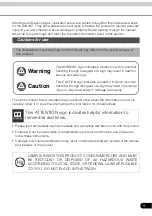
INSTALLING AND POINTING YOUR SATELLITE DISH
P
AGE
4-19
The INSTALLATION Screen
The
INSTALLATION
screen shows the quality of the signal that you are receiving. Because you
have not adjusted the direction of your satellite dish, you probably
have a signal strength of 0. To let you know that it is “looking,” you
should hear a short beep every few seconds.
Even though a signal strength of 50 will give you the same high-
quality picture and sound as a reading of 90, you should maximize
your signal as much as possible, because rain or snow can cause the
signal strength to drop significantly. This signal reduction is known
as “rain fade.” As soon as the signal can penetrate the rain cloud or
snow, your picture will return automatically.
Pointing the Dish Using the “Box” Method
The easiest way to find the satellite signal is by scanning the sky in the general direction that the
satellite is located. While you could possibly achieve this by trial and
error, you should be able to find the signal in just a few minutes
using what is called the “box” method. What you are effectively
doing is scanning the sky in a pattern similar to the way a farmer
plows a field.
It will be easiest to fine-tune your dish with someone else’s
assistance, calling out the signal strength while you make the
adjustments. Optionally, you can turn up the volume of your TV so
that you can hear the beeps while you make adjustments. When there
is no signal, beeps will occur every few seconds so that you know it
is searching. As the signal strength increases, the beeps will become
much more rapid.
Before you begin make these quick checks:
•
Verify that there are no obstructions such as trees, buildings, etc., blocking the signal.
•
Verify that you are using the proper cable type (RG-6) between the dish and the receiver.
Also, be sure that the connections are tight and the center wire in the cable extends about
1/8
th
-inch beyond the end of the connector.
•
Verify that the azimuth and elevation values that you determined earlier are correct for
your area.
•
To loosen and tighten the antenna’s bolts, you will need a 7/16-inch wrench (not
included).
•
A compass will also be needed to establish the initial direction to point your satellite dish.
The “box” method begins by subtracting 10 degrees from the azimuth and subtracting 4 degrees
from the elevation values that you determined earlier.
We’ll begin by adjusting the elevation. First, loosen the nuts securing the two (one on each side)
elevation bolts just enough so that you can easily tilt the reflector up and down. Next, line up the
elevation indicator with the tick mark corresponding to the elevation calculated earlier (result
minus 4 degrees).
This mark may appear as a pointer or as a painted edge. Do not use the
bolt or nut as a point of reference.
Finish adjusting the elevation by lightly tightening the bolts
The INSTALLATION screen
(HIRD-B model receiver screen shown)
Pattern of scanning the sky
Summary of Contents for HIRD-B2
Page 1: ...Models HIRD B2 HIRD B3 HIRD B4 HIRD C2 O W N E R S M A N U A L Model HIRD B4 shown ...
Page 6: ......
Page 14: ...HUGHES BRAND DIRECTV SYSTEM OWNER S MANUAL PAGE 1 6 ...
Page 22: ...HUGHES BRAND DIRECTV SYSTEM OWNER S MANUAL PAGE 2 8 ...
Page 46: ...HUGHES BRAND DIRECTV SYSTEM OWNER S MANUAL PAGE 4 22 ...
Page 50: ...HUGHES BRAND DIRECTV SYSTEM OWNER S MANUAL PAGE 5 4 ...
Page 78: ...HUGHES BRAND DIRECTV SYSTEM OWNER S MANUAL PAGE 7 18 ...
Page 88: ...HUGHES BRAND DIRECTV SYSTEM OWNER S MANUAL PAGE 9 6 ...
Page 92: ...Part 1026005 0001 Revision B ...
















































